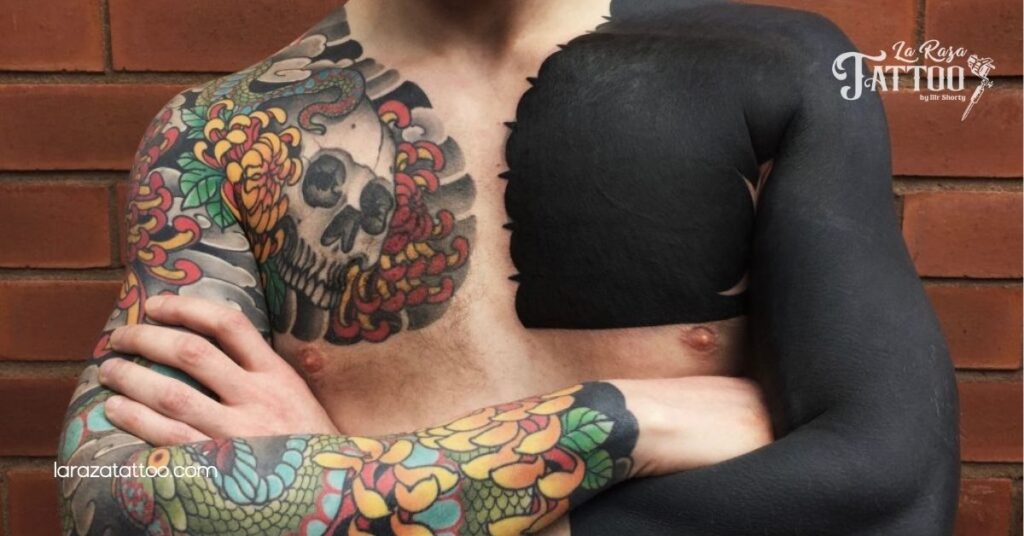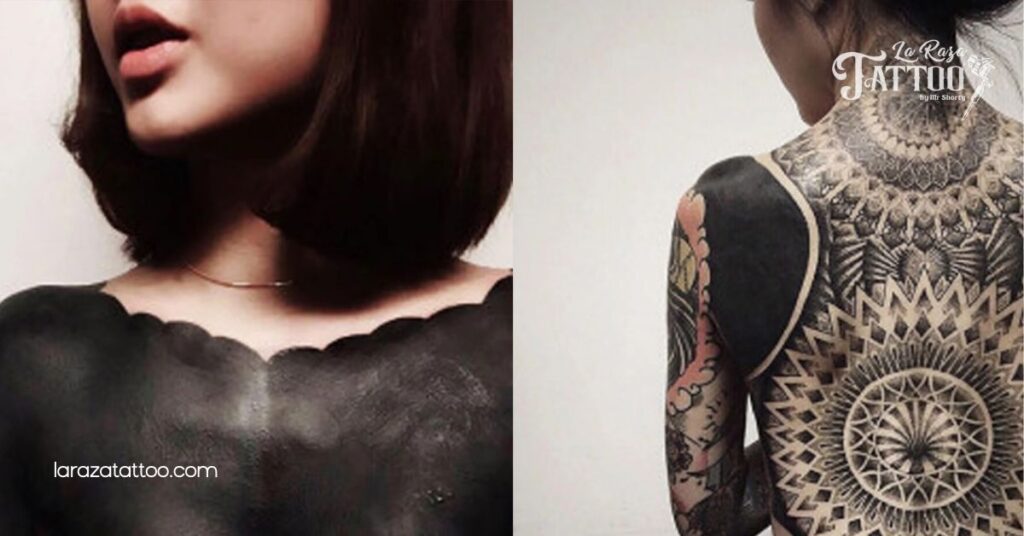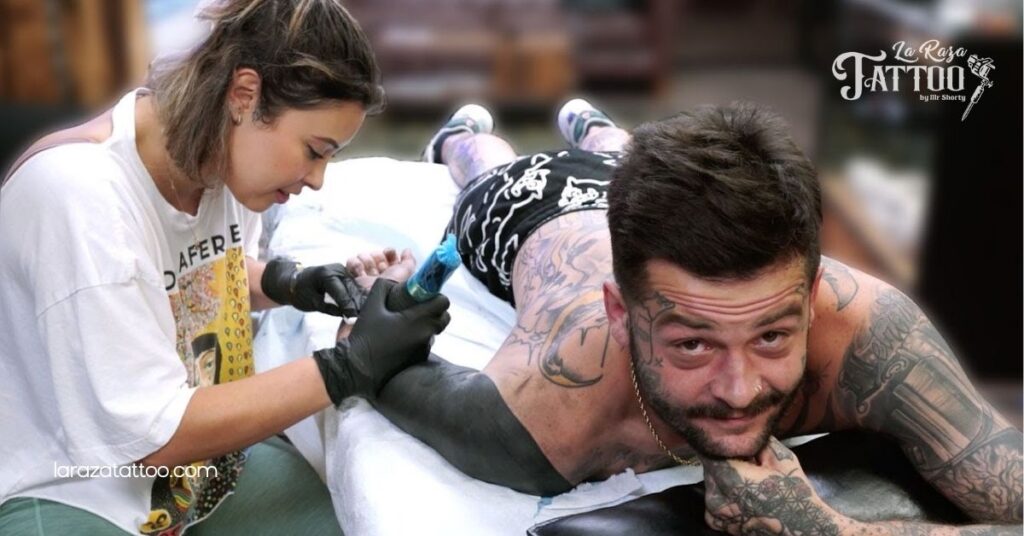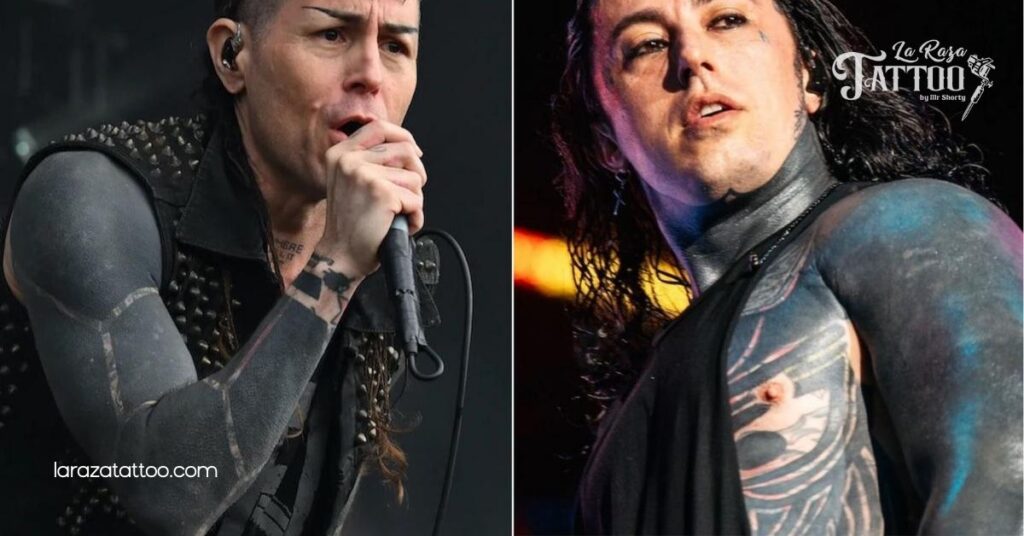Imagine transforming your skin into a bold canvas that tells your unique story. Blackout tattoos are more than just a trend; they’re a powerful form of self-expression that allows you to reclaim your body in a striking way. By covering up unwanted ink or simply making a statement, these tattoos offer a fresh perspective on body art.
You might be wondering what makes blackout tattoos so appealing. With their dramatic black designs, they create a striking contrast against your skin, turning heads and sparking conversations. Whether you’re looking to cover past mistakes or embrace a minimalist aesthetic, blackout tattoos can redefine your relationship with body art. Jump into the industry of blackout tattoos and discover how they can elevate your personal style while making a bold statement.
Understanding Blackout Tattoos

Blackout tattoos are more than just ink; they’re a bold statement of personal identity. These tattoos cover larger areas of skin with solid black ink, creating a striking visual impact.
Definition of Blackout Tattoos
A blackout tattoo involves saturating a exact area of your skin completely with black ink. You’ll find these tattoos often used to transform or conceal previous tattoos. Artists typically apply black ink in layered sessions, creating a smooth, even surface. This approach often resonates with those seeking a dramatic aesthetic while also serving as a canvas for personal expression.
History of Blackout Tattoos
The origins of blackout tattoos can be traced back to traditional tribal body art. Indigenous cultures incorporated bold, solid designs on their skins for spiritual or status reasons. In the early 2000s, this art form started gaining traction in mainstream tattoo culture. Modern tattoo artists began experimenting with blackout techniques, allowing you to reclaim space on your body. As a result, blackout tattoos have evolved into a distinct style recognized for their striking uniqueness and versatility.
The Popularity of Blackout Tattoos

Blackout tattoos have captured attention and gained a important following in recent years. Their appeal lies in how they combine artistry and personal expression.
Reasons for Choosing Blackout Tattoos
Bold artistry attracts many people to blackout tattoos. These striking designs make powerful visual statements, often symbolizing strength and resilience. Transforming previous tattoos is another reason individuals opt for blackout styles. You can reclaim your body and eliminate unwanted ink with this technique. Minimalist aesthetics appeal to others seeking simplicity without losing individuality. For some, blackout tattoos serve as a canvas for creativity, allowing unique styles that stand out.
Cultural Influence on Blackout Tattoos
Social media plays a crucial role in the rise of blackout tattoos. Platforms like Instagram have turned artists, such as Chester Lee, into trendsetters, boosting exposure and acceptance. Influences from various cultures also shape this tattoo style. Many tribal and traditional body art forms share similarities with blackout techniques. As tattoos become more mainstream, you’ll find a broader acceptance of blackout designs among diverse communities, reflecting personal stories and cultural significance in everyday life.
The Process of Getting Blackout Tattoos

Getting a blackout tattoo involves several essential steps, ensuring a smooth and satisfying experience.
Consultation and Design
During your consultation, you’ll have a detailed discussion with the tattoo artist about your vision. You’ll talk about the size, placement, and design of the tattoo, especially if you have existing ink that needs to be covered. Your preferences are crucial, so the artist makes sure the design reflects your artistic vision. Feel free to ask questions or voice concerns; great communication helps establish trust between you and the artist. Forming that rapport not only makes the process enjoyable but also ensures your expectations are met.
Tattooing Techniques for Blackout Tattoos
Multiple techniques are employed to achieve the bold effect of a blackout tattoo. Layering is one of the primary methods where your tattoo artist revisits the same area several times. This technique helps in creating a deep, solid black color that truly stands out. Expect the process to require patience since achieving that desired saturation might take a few sessions. Strong artistry shines through in the careful execution of these techniques, ensuring a smooth finish you’ll love.
Aftercare for Blackout Tattoos
After getting your blackout tattoo, proper aftercare is vital for healing. Keep the tattoo clean and moisturized to prevent any complications in the healing process. It’s essential to follow the artist’s instructions, which typically include avoiding direct sunlight and refraining from soaking in water for a while. Regularly checking your tattoo will help you notice any issues early on. By taking care of your new ink, you ensure not only its longevity but also maintain its striking appearance.
Pros and Cons of Blackout Tattoos

When considering blackout tattoos, you’ll want to weigh the advantages against the disadvantages. Here’s a closer look:
Advantages of Blackout Tattoos
- Blackout tattoos create a bold, minimalist aesthetic that makes a strong statement. This powerful visual impact sets you apart from traditional tattoo styles, catching the eye and sparking conversations.
- They effectively cover old tattoos and scars. If you’re looking to erase faded or unwanted ink, blackout tattoos provide a fresh canvas by seamlessly concealing your previous tattoos.
- Blackout tattoos offer versatility in design. You’ll find that they can incorporate negative space designs, geometric patterns, and intricate details, allowing for personalized art that truly reflects your style.
- The timeless appeal of solid black ink endures. Unlike trendy designs, blackout tattoos maintain visual prominence over time, ensuring that your choice remains stylish for years to come.
- Blackout tattoos express individuality and a sense of rebellion. Choosing this tattoo style positions you against mainstream trends, making a definitive statement about your identity.
Disadvantages of Blackout Tattoos
- The pain level can be more intense compared to traditional tattoos. The greater skin coverage required may lead to a longer, more uncomfortable inking process.
- You’ll need to consider the extensive healing time. Blackout tattoos often require careful aftercare since a larger area of skin is affected, demanding special attention during recovery.
- They limit future tattoo options. Opting for blackout designs can restrict your ability to add new ink later, as large sections of skin will be permanently covered.
- Some people may see them as overly aggressive or unapproachable. The dramatic nature of blackout tattoos might not resonate with everyone’s personal style or social circles.
- The cost can be higher due to the complexity. Blackout tattoos typically necessitate multiple sessions with skilled artists, which can elevate the overall expense compared to smaller, simpler designs.
Notable Blackout Tattoo Artists

Several talented tattoo artists have made a name for themselves in the industry of blackout tattoos. Here’s a look at some leading figures in this unique art form.
Profiles of Leading Blackout Tattoo Artists
Jeanmarco Cicolini stands out with his extensive experience across various cities in the United States. Hailing from Italy, he brings a fresh perspective to the artistry of blackout tattoos. You can find him tattooing in places like Texas, Chicago, New Jersey, New York City, San Diego, and Miami. Each location not only adds to his exposure but also influences his artistic style.
Their Unique Styles and Techniques
Artists like Jeanmarco display a mastery of solid black ink application. He often uses a layering technique to achieve an even saturation that makes the tattoo pop against the skin. Creativity flows in his designs, allowing him to transform ideas into striking visuals. You’ll notice that his work often emphasizes bold lines with no shading, further improving the dramatic impact. Many clients appreciate his ability to personalize pieces while maintaining the essence of the blackout style.
Conclusion
Blackout tattoos offer a unique avenue for self-expression and personal transformation. Whether you’re looking to cover up old ink or embrace a bold minimalist aesthetic, these tattoos can be a powerful statement of your identity. With their striking designs and cultural significance, blackout tattoos not only enhance your style but also tell a story that’s uniquely yours.
As you consider this art form, remember to think about your vision and consult with a skilled artist who understands the intricacies of the technique. With proper care and thought, a blackout tattoo can become a lasting symbol of strength and resilience in your life. Embrace the journey and let your body reflect your personal narrative.
Frequently Asked Questions
What are blackout tattoos?
Blackout tattoos are a form of body art that involves saturating areas of the skin with solid black ink. They are used either to cover unwanted tattoos or as a bold statement of personal identity and self-expression.
Why are blackout tattoos popular?
Blackout tattoos have gained popularity for their striking designs, ability to cover previous ink, and minimalist aesthetic. Social media has further fueled their acceptance and trendiness, showcasing various artists and styles.
How are blackout tattoos applied?
The process typically starts with a consultation between the client and tattoo artist, followed by multiple sessions of layering black ink to achieve a smooth finish. This technique allows for personalized designs and adequate saturation of color.
What are the benefits of blackout tattoos?
Benefits include their bold aesthetic, effectiveness in covering scars or old tattoos, timeless appeal, and expression of individuality. They also allow for creative designs that can enhance personal style.
What are the drawbacks of blackout tattoos?
Drawbacks include increased pain during application, a longer healing process, limited options for future tattoos, and potentially negative perceptions. Additionally, costs may be higher due to the complexity of the designs.
Who are notable blackout tattoo artists?
Notable artists include Jeanmarco Cicolini, renowned for his solid black ink application and layering techniques. His work emphasizes bold lines and even saturation, making him a pioneer in the blackout tattoo style.
How should I care for my blackout tattoo?
Aftercare is crucial for healing. Keep the tattoo clean and moisturized, avoid direct sunlight, and refrain from soaking it in water. Proper aftercare ensures the tattoo remains vibrant and well-preserved.
Can blackout tattoos be removed?
Removing blackout tattoos is challenging and often requires laser removal, which can be painful and expensive. It’s essential to carefully consider this before committing, as covering them up is often easier than removal.






